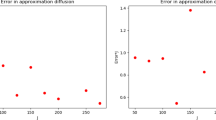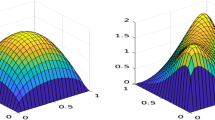Abstract
We introduce a general solution concept for the Fokker–Planck (Kolmogorov) equation representing the diffusion limit of the Wright–Fisher model of random genetic drift for an arbitrary number of alleles at a single locus. This solution will continue beyond the transitions from the loss of alleles, that is, it will naturally extend to the boundary strata of the probability simplex on which the diffusion is defined. This also takes care of the degeneracy of the diffusion operator at the boundary. We shall then show the existence and uniqueness of a solution. From this solution, we can readily deduce information about the evolution of a Wright–Fisher population.
Similar content being viewed by others
References
Buss, S.R., Clote, P.: Solving the Fisher–Wright and coalescence problems with a discrete Markov chain analysis. Adv. Appl. Probab. 36(4), 1175–1197 (2004)
Bürger, R.: The Mathematical Theory of Selection, Recombination, and Mutation. John Wiley, New York (2000)
Epstein, C.L., Mazzeo, R.: Wright–Fisher diffusion in one dimension. SIAM J. Math. Anal. 42, 568–608 (2010)
Epstein, C.L., Mazzeo, R.: Degenerate Diffusion Operators Arising in Population Biology. Princeton University Press, Princeton (2013)
Ethier, S.N.: A class of degenerate diffusion processes occurring in population genetics. Commun. Pure Appl. Math. 29, 483–493 (1976)
Ethier, S.N., Kurtz, T.: Markov Processes: Characterization and Convergence. Wiley (1986), New York (2005)
Ethier, S.N., Nagylaki, T.: Diffusion approximations of Markov chains with two time scales and applications to population genetics. Adv. Appl. Probab. 12, 14–49 (1980)
Ethier, S.N., Nagylaki, T.: Diffusion approximations of the two-locus Wright–Fisher model. J. Math. Biol. 27, 17–28 (1989)
Ewens, W.J.: Mathematical population genetics I. Theoretical introduction. In: Interdisciplinary Applied Mathematics, 2nd edn. Springer, New York (2004)
Felsenstein, J.: The rate of loss of multiple alleles in finite haploid populations. Theor. Popul. Biol. 2, 391–403 (1971)
Fisher, R.A.: On the dominance ratio. Proc. R. Soc. Edinb. 42, 321–341 (1922)
Gill, W.: Modified fixation probability in multiple alleles models in the asymmetric sharply-peaked landscape. J. Korean Phys. Soc. 55(2), 709–717 (2009)
Gladstien, K.: Subdivided populations the characteristic values and rate of loss of alleles. J. Appl. Prob. 241, 241–248 (1977)
Karlin, S., Taylor, H.M.: A Second Course in Stochastic Processes. Academic Press, New York (1981)
Kimura, M.: Solution of a process of random genetic drift with a continuous model. PNAS-USA 41(3), 144–150 (1955)
Kimura, M.: Random genetic drift in multi-allele locus. Evolution 9, 419–435 (1955)
Kimura, M.: Random genetic drift in a tri-allelic locus; exact solution with a continuous model. Biometrics 12, 57–66 (1956)
Lessard, S., Lahaie, P.: Fixation probability with multiple alleles and projected average allelic effect on selection. Theor. Popul. Biol. 75, 266–277 (2009)
Littler, R.A., Good, A.J.: Ages, extinction times, and first passage probabilities for a multiallele diffusion model with irreversible mutation. Theor. Popul. Biol. 1(3), 214–225 (1978)
Littler, R.A.: Loss of variability at one locus in a finite population. Math. Biosci. 25, 151–163 (1975)
Marth, G., et al.: Sequence variations in the public human genome data reflect a bottlenecked population history. Proc. Natl. Acad. Sci. 100.1, 376–381 (2003)
Nagylaki, T.: The decay of genetic variability in geographically structured populations. PNAS 71, 2932–2936 (1974)
Tran, T.D., Hofrichter, J., Jost, J.: An introduction to the mathematical structure of the Wright–Fisher model of population genetics. Theory Biosci. 1–10 (2012). doi:10.1007/s12064-012-0170-3
Walker, A.C., Smith, S.D., Smith, S.D.: Mitochondrial DNA and human evolution. Nature 325, 1–5 (1987)
Wright, S.: Evolution in Mendelian populations. Genetics 16, 97–159 (1931)
Acknowledgments
We would like to thank the anonymous referee for helpful comments, in particular suggestions concerning SNPs and mitochondrial DNA, as mentioned in Sect. 4. The research leading to these results has received funding from the European Research Council under the European Union’s Seventh Framework Programme (FP7/2007-2013)/ERC Grant agreement no. 267087.
Author information
Authors and Affiliations
Corresponding author
Additional information
The research leading to these results has received funding from the European Research Council under the European Union’s Seventh Framework Programme (FP7/2007-2013)/ERC Grant agreement no. 267087. T. D. Tran and J. Hofrichter have also been supported by the IMPRS “Mathematics in the Sciences”, and the material presented in this paper is largely based on the first author’s thesis.
Rights and permissions
About this article
Cite this article
Tran, T.D., Hofrichter, J. & Jost, J. A General Solution of the Wright–Fisher Model of Random Genetic Drift. Differ Equ Dyn Syst 27, 467–492 (2019). https://doi.org/10.1007/s12591-016-0289-7
Published:
Issue Date:
DOI: https://doi.org/10.1007/s12591-016-0289-7




